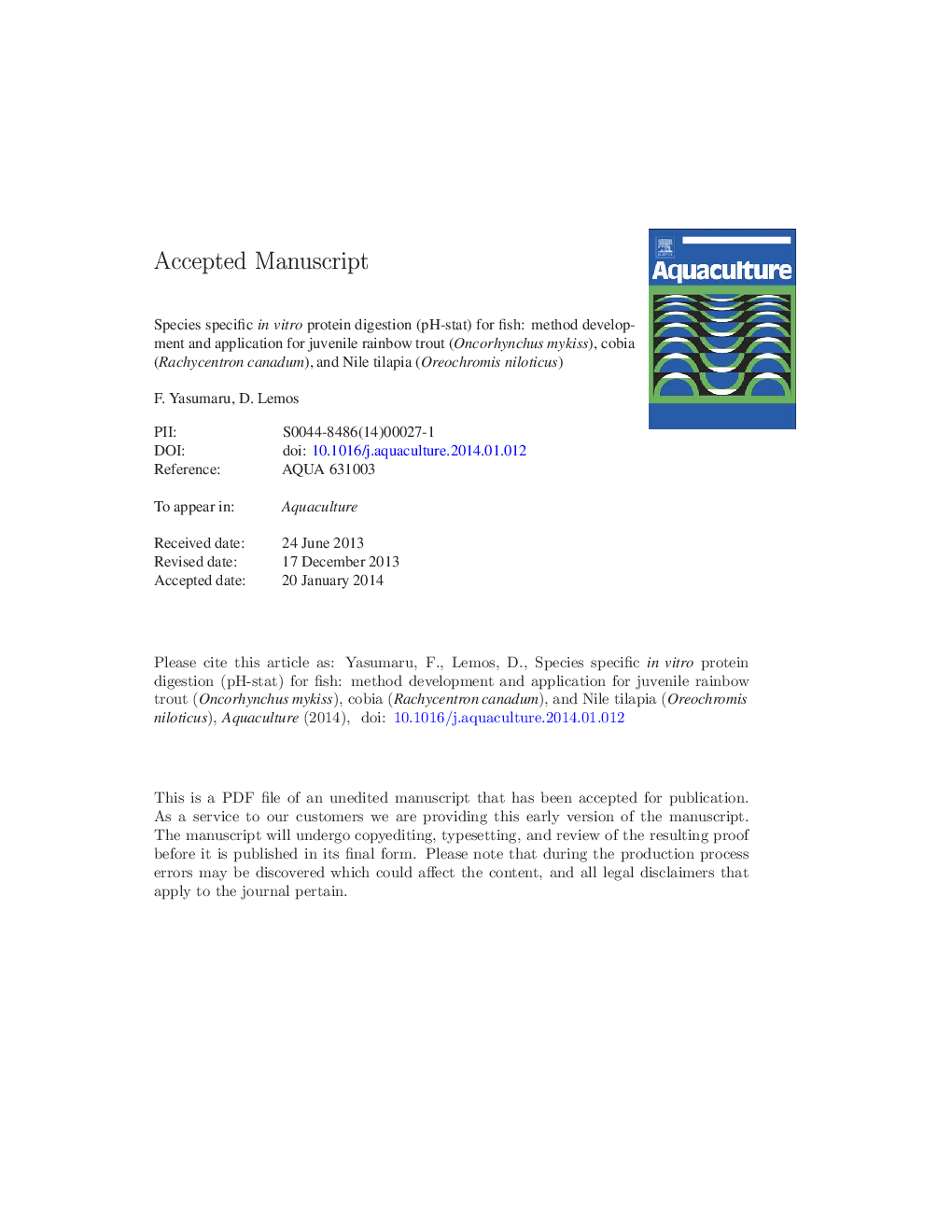| کد مقاله | کد نشریه | سال انتشار | مقاله انگلیسی | نسخه تمام متن |
|---|---|---|---|---|
| 8495145 | 1552859 | 2014 | 44 صفحه PDF | دانلود رایگان |
عنوان انگلیسی مقاله ISI
Species specific in vitro protein digestion (pH-stat) for fish: method development and application for juvenile rainbow trout (Oncorhynchus mykiss), cobia (Rachycentron canadum), and Nile tilapia (Oreochromis niloticus)
دانلود مقاله + سفارش ترجمه
دانلود مقاله ISI انگلیسی
رایگان برای ایرانیان
کلمات کلیدی
موضوعات مرتبط
علوم زیستی و بیوفناوری
علوم کشاورزی و بیولوژیک
علوم آبزیان
پیش نمایش صفحه اول مقاله

چکیده انگلیسی
Aqua feed manufacture requires flexible formulations and effective methods to screen suitable feed ingredients. In vitro digestion may assist in the characterization and quality control of protein in feedstuffs for fish species once standardized species-specific digestive enzyme extracts are available. This study aimed to develop a species-specific in vitro enzymatic method to assess protein digestion in fish under the pH-stat concept. Two carnivorous (rainbow trout, Oncorhynchus mykiss, and cobia, Rachycentron canadum) and one omnivorous (Nile tilapia, Oreochromis niloticus) fish species were used as models. Crude digestive enzyme extracts were recovered from stomach and pyloric caeca or intestine of individuals of different weight groups, feeding status, and farming systems. The hydrolytic capacity of the species-specific enzyme extracts was standardized on purified protein substrates and measured as degree of protein hydrolysis (DH) in the pH-stat assay. A group of twenty-four feed ingredients, including fish meals and by-products of plant and animal origin, was assessed for DH using the recovered enzymes from stomach and pyloric caeca/intestine. Ingredients were hydrolyzed with fish (i) stomach extract, (ii) pyloric caeca/intestine extract or (iii) stomach enzymes followed by pyloric caeca/intestine extract. Among plant by-products, cotton seed meal presented the highest DH with stomach plus pyloric caeca/intestine enzymes, followed by soy protein concentrate and soybean meals. Blood meals were the land animal by-product with higher DH outputs compared to poultry by-product meals and feather meals. No significant difference was observed among the DHs of fish meals. The significance of measuring the DH with stomach enzyme extract is still not well understood but, overall, the pre-hydrolysis of feedstuffs with stomach enzymes increased pyloric caeca/intestine DH value. For cage and pond farmed Nile tilapia, ingredient DHs followed the same trend, describing a significant correlation and a high determination coefficient regression. Routine use of the method may yet depend on the prompt availability of more practical sources of enzymes. The determination of the degree of protein hydrolysis by the in vitro pH-stat with species-specific enzymes has shown to be a precise method that may be a useful tool to rank feed ingredients, and also an accessory method in the quality control of feedstuffs.
ناشر
Database: Elsevier - ScienceDirect (ساینس دایرکت)
Journal: Aquaculture - Volumes 426â427, 20 April 2014, Pages 74-84
Journal: Aquaculture - Volumes 426â427, 20 April 2014, Pages 74-84
نویسندگان
F. Yasumaru, D. Lemos,